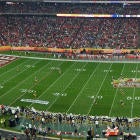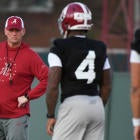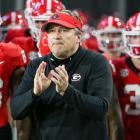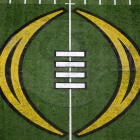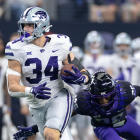As a player, Michigan coach Jim Harbaugh experienced what he described as the "hair on fire" feeling of covering a kickoff. For a competitive person, Harbaugh said, it's one of the great thrills in life.
"You're trying to be the fastest guy on the field from Point A to Point B," Harbaugh said Monday at the 2016 Big Ten Media Days. "And you're going to get hit. Somebody's coming to block you. That's a wonderful feeling and thrill, probably like a guy who takes off on a skateboard and does one of those half pipe loops and goes upside down. For people that get a great thrill out of that, can you just take that away from them?"
Maybe. Pop Warner is eliminating the kickoff for some of its youth players. Dennis Dodd reported last week that preliminary talks have started about possibly doing the same for college football, though any change probably wouldn't come until after the 2017 season.
Among some college football coaches, the idea of eliminating kickoffs for safety reasons has drawn mixed reviews. Others are skeptical about the actual danger a kick return poses for players.
"They always come out and say it would help with concussions but nobody shows you the statistics," Louisville coach Bobby Petrino said. "Does it really help? One year we didn't like that the ball was being kicked out of the end zone so we moved it back so we'd get more returns. It's kind of who's the special interest on it. It's always been a big part of the football game, but if it is causing injuries and it's something that we need to take away to improve that, we could get away with it. But is it really? Where's the stats? That's the frustrating thing for us as coaches is they don't show us any statistics."
As part of its ongoing concussion research, the Ivy League found that over the past three years kickoff returns accounted for 23.4 percent of concussions during games despite representing only 5.8 percent of overall plays. This year, the Ivy League will kick off from the 40-yard line instead of the 35; its touchbacks will be placed at the 20-yard line instead of the 25. The NCAA is allowing this as an experimental rule.
"To actually eliminate a part of the game like the kickoff I think would be more challenging and our data don't necessarily indicate we need to do that right now," Ivy League executive director Robin Harris said. "Even though 23.4 percent of our concussions occur during kickoffs, it's still not a huge number, so I'm not prepared right now to say kickoffs are inherently dangerous. It's something we have concerns about, and we'll continue to monitor and see if we can get that number down."
Part of the problem is there's not much data -- or at least not much that the public and most coaches have seen. The NCAA has not publicly released injury data on kickoffs that it's sharing with the American Football Coaches Association's board of trustees and the NCAA Division I Football Oversight Committee.
Kevin Guskiewicz, a brain injury researcher at the University of North Carolina, presented information to the NFL's competition committee in 2011 showing kickoff returns are the most likely to cause head injuries. He provided data from his project with accelerometers on helmets that showed many of the highest G-force collisions come on kickoffs. By moving the kickoff up 5 yards, the NFL saw a 42-percent reduction in concussions on kickoffs and the NCAA had a 50-percent reduction, Guskiewicz told the Raleigh News & Observer in 2015.
It's not just concussions that worry some people about kickoffs. Other injuries can occur during high-impact kickoff returns, which many have labeled as football's most dangerous play. The Ivy League is only studying concussions on kick returns, not other injuries, and it hasn't received data yet from the Big Ten as part of their joint collaboration.
"I think we're the only one collecting data as a conference," Harris said. "We were concerned about the lack of data and that's why we started our study three years ago."
Duke coach David Cutcliffe, a board member for the AFCA, said he watches kickoff coverage and returns "with grimaces at times on my face" because of the hits.
"As a football coach and as a person who cares a lot about student-athletes, I think we've got to really look at this play," Cutcliffe said. "If the 40-yard line significantly impacts the touchbacks, I think it's worth looking at."
Last year, 39 percent of Football Bowl Subdivision kickoffs resulted in touchbacks (a small increase from 37 percent in 2014 and 36 percent in 2013). Arizona State led the country last season at 75 percent. The percentage of touchbacks declines at lower levels: 23 percent in the Football Championship Subdivision, 19 percent in Division II and 12 percent in Division III.
For several years, the NFL has tried to wean itself off kickoff returns. Five years ago, the kickoff was moved from the 30-yard line to the 35. The number of NFL touchbacks went from 16.4 percent in 2010 to 43.5 percent in 2011.
Last season, the NFL was up to a 56-percent touchback rate. Still, injuries on kickoff returns rose in 2015, Atlanta Falcons president Rich McKay told ESPN in March.
This season, the NFL will experiment with moving a touchback to the 25-yard line in hopes of limiting the number of kick returns. However, it's possible the rule change could lead some teams to use high, short kicks that pin a returner before the goal line and force him to bring the ball out.
"There are a lot of games, from Super Bowls to high school championships, won or lost with the special teams," said former NFL and college coach Dave Wannstedt. "When you get into special teams, particularly at a lower level, you're getting guys like walk-on players. Those are their only opportunity to play. ... Move [the kickoff] up, make them pooch kick it or do something. See how that works. I wouldn't be in favor of eliminating it at this point."
New York Giants president John Mara told NFL.com in March that if the league could determine how to handle the onside kick for end-of-game situations, the NFL would likely seriously consider eliminating the kickoff altogether. Finding a way to save the onside kick -- a play that occurred on 2 percent of college football kickoffs in 2015 -- is a big concern of college coaches.
"The problem I have with taking the play out of the game is when you're behind, onside kicks or surprise onside kicks, how do you manage that?" Cutcliffe said. "How do you catch back up? That's going to take some really smart people. So I think the next step before losing the play, I would be all for the 40-yard line [for the kickoff]. ... The 40-yard line still allows for onside kicks. I may onside kick it all the time because it's midfield now. It would encourage me."
Harris, the Ivy League director, said if the kickoff went away perhaps you simply allow a coach to signal in advance a late-game, onside kick attempt. "Everybody knows when it's an onside kick anyway," she said. "If people really want it, I don't think that's where injuries are happening."
Still, that doesn't account for the surprise onside kick, which is a huge strategic play that can swing a game. Alabama won the national championship in 2015 largely because Nick Saban bought his defense an extra possession of rest by boldly calling for a fourth-quarter onside kick that the Crimson Tide recovered against Clemson.
"You take the onside kick away, that's a big part of this game," said Florida State coach Jimbo Fisher, who isn't opposed to moving the kickoff to the 40. "But we've also got to look at health reasons. I don't know the answer, but we need to do research before we go crazy."
In March, Pop Warner became the first national football organization to eliminate kickoffs. The ban is for Pop Warner's three youngest divisions (ages 5-7, 7-9 and 8-10). Instead of kickoffs, the ball will be placed at the 35-yard line at the start of each half and after each score.
After Rutgers defensive tackle Eric LeGrand was paralyzed in 2010 while making a tackle on a kickoff, then-Rutgers coach Greg Schiano called for kickoffs to be abolished. The most unique part of Schiano's idea was to put the ball back in the hands of the team that scored. Under Schiano's plan, instead of a kickoff, the kicking team would have a fourth-and-15 from its own 30. The team could either punt, which is considered a safer play than a kickoff, or try to convert a fourth-and-15 that would replace the onside kick as a strategic gamble.
"That one is not going to happen," Petrino said, laughing.
Cutcliffe said Schiano's idea did not get discussed much at the time within the coaching community.
"It's not a bad thought, and I think it's a thing that has to go into a think tank," Cutcliffe said. "What's the law of unintended consequences that are going to occur? Too often we've had rules changes where we've had to go, oops, and we've immediately fixed it. It takes a lot of people that know what they're doing to talk through these things."
Coaches have a role to make decisions that directly protect the players as best they can, and not "indirectly or from a media standpoint," Cutcliffe said. "The players are more important than the game because they are the game."












